IAASA's Role in Financial Reporting: Regulations and Key Topics 2013
VerifiedAdded on 2023/06/14
|11
|2735
|425
Report
AI Summary
This report discusses the role and functions of the regulatory framework in financial reporting within Ireland and internationally. It identifies limitations in international regulations and analyzes key topics from IAASA's 2013 observation document, including impairment testing, deferred tax assets, forbearance measures, provisions, pension liabilities, and alternative performance measures. IAASA's role involves promoting improvements in financial reporting quality, auditing, and adherence to professional standards. The report also addresses challenges like uncertain tax positions and potential infringements. It concludes that while IAASA plays a vital role, international regulations face limitations due to inflexibility. The analysis of IAASA's reports reveals improvements in risk disclosures and fair value quality but emphasizes the need for continuous improvement in financial reporting practices.
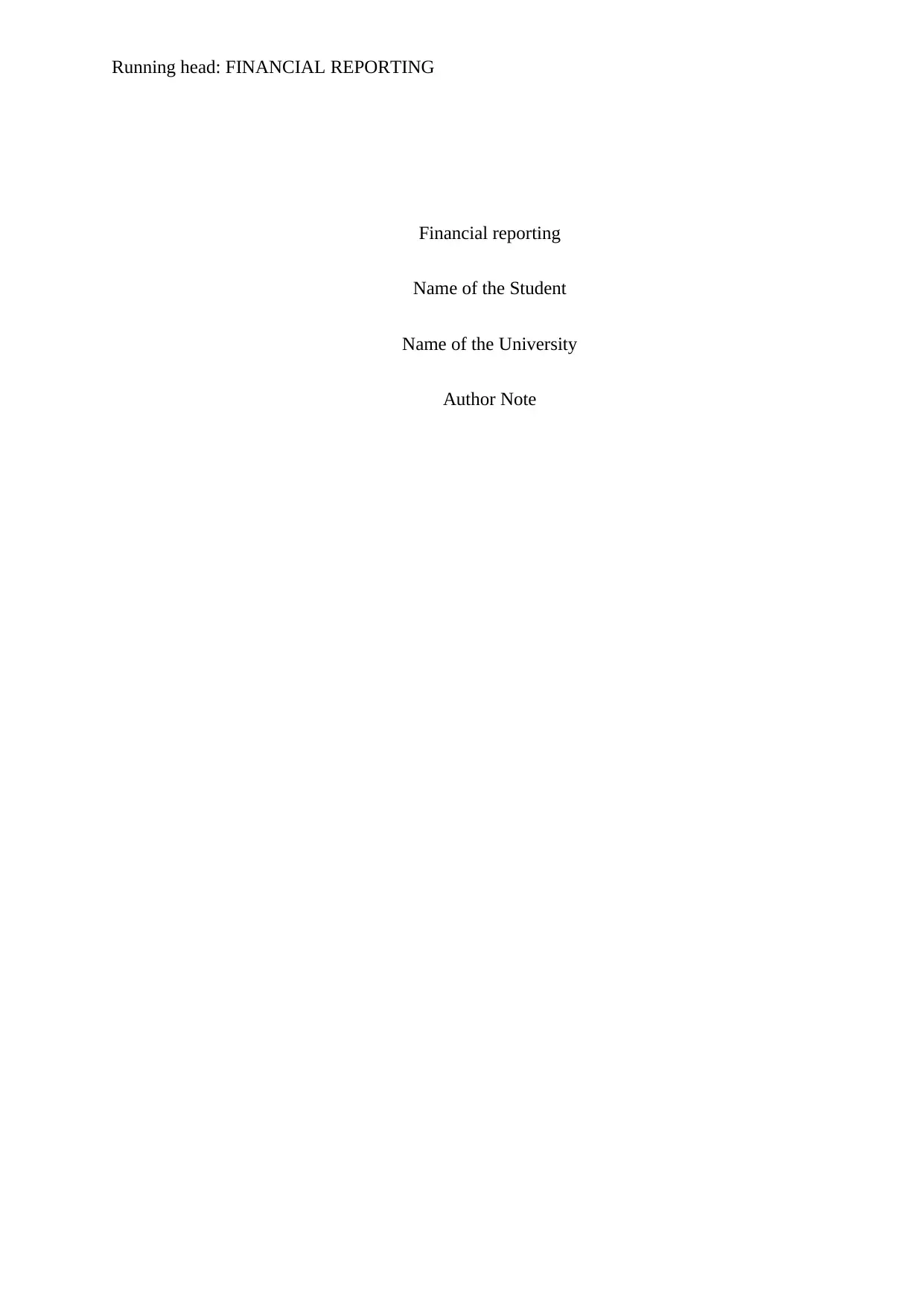
Running head: FINANCIAL REPORTING
Financial reporting
Name of the Student
Name of the University
Author Note
Financial reporting
Name of the Student
Name of the University
Author Note
Paraphrase This Document
Need a fresh take? Get an instant paraphrase of this document with our AI Paraphraser
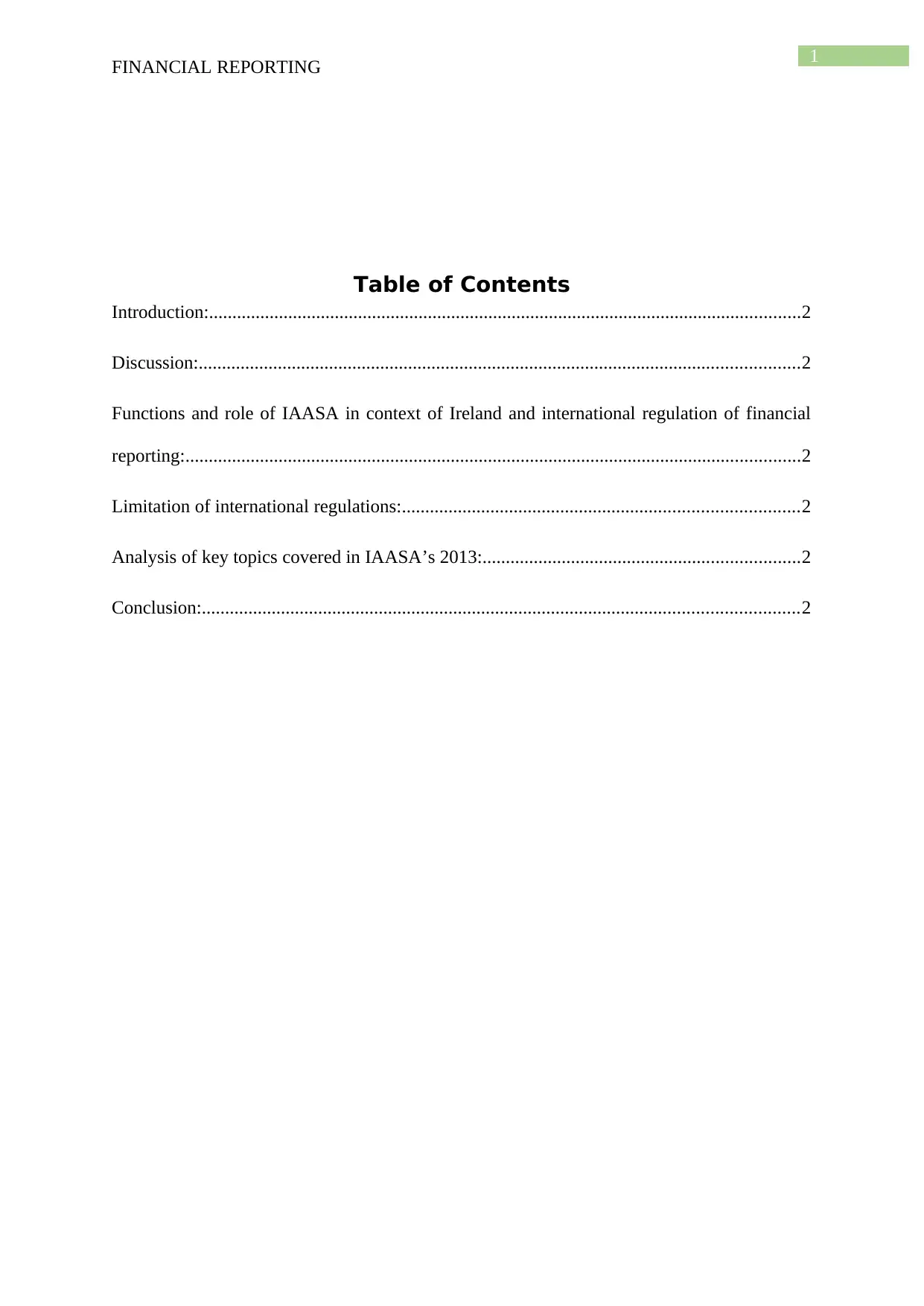
1
FINANCIAL REPORTING
Table of Contents
Introduction:...............................................................................................................................2
Discussion:.................................................................................................................................2
Functions and role of IAASA in context of Ireland and international regulation of financial
reporting:....................................................................................................................................2
Limitation of international regulations:.....................................................................................2
Analysis of key topics covered in IAASA’s 2013:....................................................................2
Conclusion:................................................................................................................................2
FINANCIAL REPORTING
Table of Contents
Introduction:...............................................................................................................................2
Discussion:.................................................................................................................................2
Functions and role of IAASA in context of Ireland and international regulation of financial
reporting:....................................................................................................................................2
Limitation of international regulations:.....................................................................................2
Analysis of key topics covered in IAASA’s 2013:....................................................................2
Conclusion:................................................................................................................................2
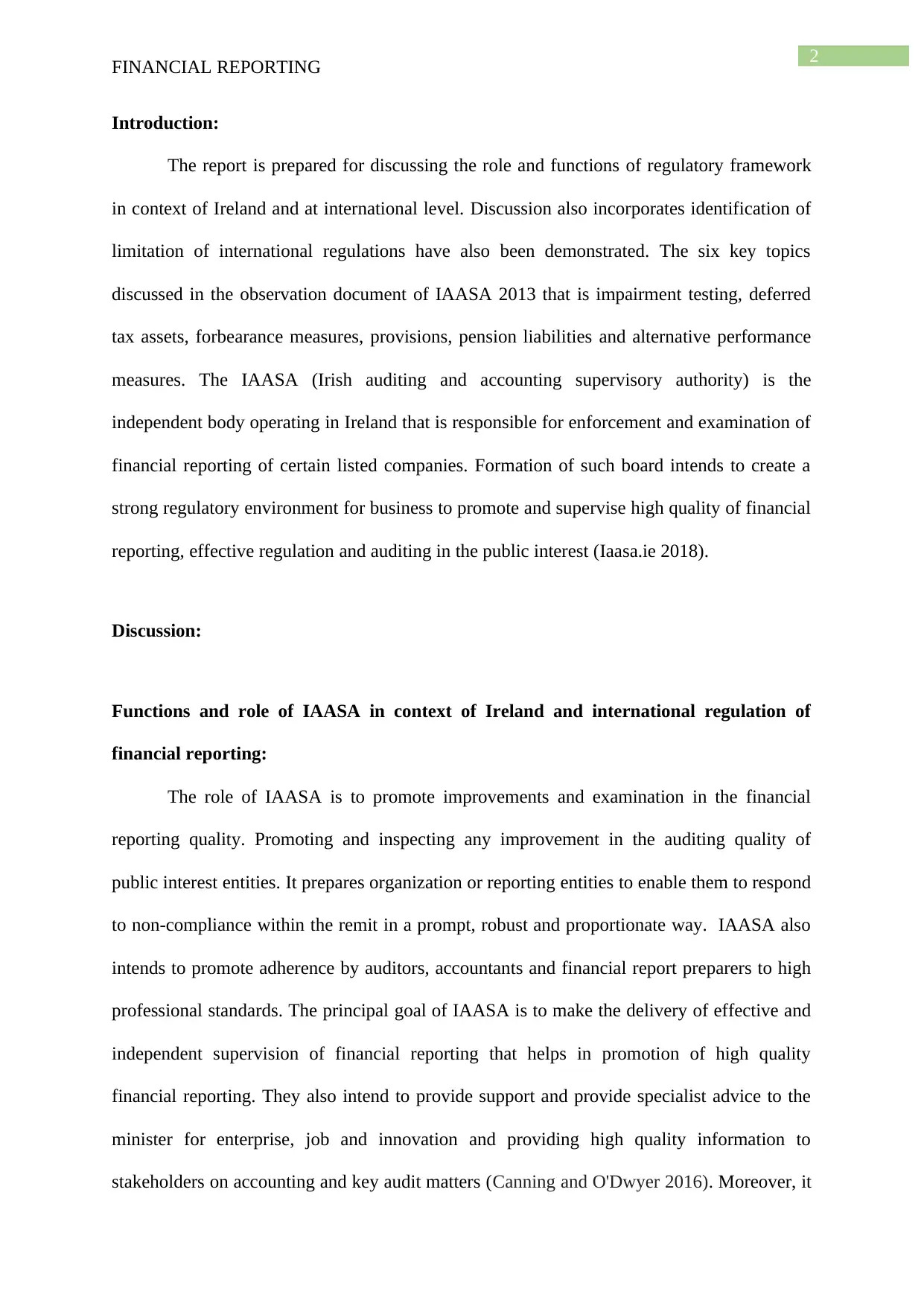
2
FINANCIAL REPORTING
Introduction:
The report is prepared for discussing the role and functions of regulatory framework
in context of Ireland and at international level. Discussion also incorporates identification of
limitation of international regulations have also been demonstrated. The six key topics
discussed in the observation document of IAASA 2013 that is impairment testing, deferred
tax assets, forbearance measures, provisions, pension liabilities and alternative performance
measures. The IAASA (Irish auditing and accounting supervisory authority) is the
independent body operating in Ireland that is responsible for enforcement and examination of
financial reporting of certain listed companies. Formation of such board intends to create a
strong regulatory environment for business to promote and supervise high quality of financial
reporting, effective regulation and auditing in the public interest (Iaasa.ie 2018).
Discussion:
Functions and role of IAASA in context of Ireland and international regulation of
financial reporting:
The role of IAASA is to promote improvements and examination in the financial
reporting quality. Promoting and inspecting any improvement in the auditing quality of
public interest entities. It prepares organization or reporting entities to enable them to respond
to non-compliance within the remit in a prompt, robust and proportionate way. IAASA also
intends to promote adherence by auditors, accountants and financial report preparers to high
professional standards. The principal goal of IAASA is to make the delivery of effective and
independent supervision of financial reporting that helps in promotion of high quality
financial reporting. They also intend to provide support and provide specialist advice to the
minister for enterprise, job and innovation and providing high quality information to
stakeholders on accounting and key audit matters (Canning and O'Dwyer 2016). Moreover, it
FINANCIAL REPORTING
Introduction:
The report is prepared for discussing the role and functions of regulatory framework
in context of Ireland and at international level. Discussion also incorporates identification of
limitation of international regulations have also been demonstrated. The six key topics
discussed in the observation document of IAASA 2013 that is impairment testing, deferred
tax assets, forbearance measures, provisions, pension liabilities and alternative performance
measures. The IAASA (Irish auditing and accounting supervisory authority) is the
independent body operating in Ireland that is responsible for enforcement and examination of
financial reporting of certain listed companies. Formation of such board intends to create a
strong regulatory environment for business to promote and supervise high quality of financial
reporting, effective regulation and auditing in the public interest (Iaasa.ie 2018).
Discussion:
Functions and role of IAASA in context of Ireland and international regulation of
financial reporting:
The role of IAASA is to promote improvements and examination in the financial
reporting quality. Promoting and inspecting any improvement in the auditing quality of
public interest entities. It prepares organization or reporting entities to enable them to respond
to non-compliance within the remit in a prompt, robust and proportionate way. IAASA also
intends to promote adherence by auditors, accountants and financial report preparers to high
professional standards. The principal goal of IAASA is to make the delivery of effective and
independent supervision of financial reporting that helps in promotion of high quality
financial reporting. They also intend to provide support and provide specialist advice to the
minister for enterprise, job and innovation and providing high quality information to
stakeholders on accounting and key audit matters (Canning and O'Dwyer 2016). Moreover, it
⊘ This is a preview!⊘
Do you want full access?
Subscribe today to unlock all pages.

Trusted by 1+ million students worldwide
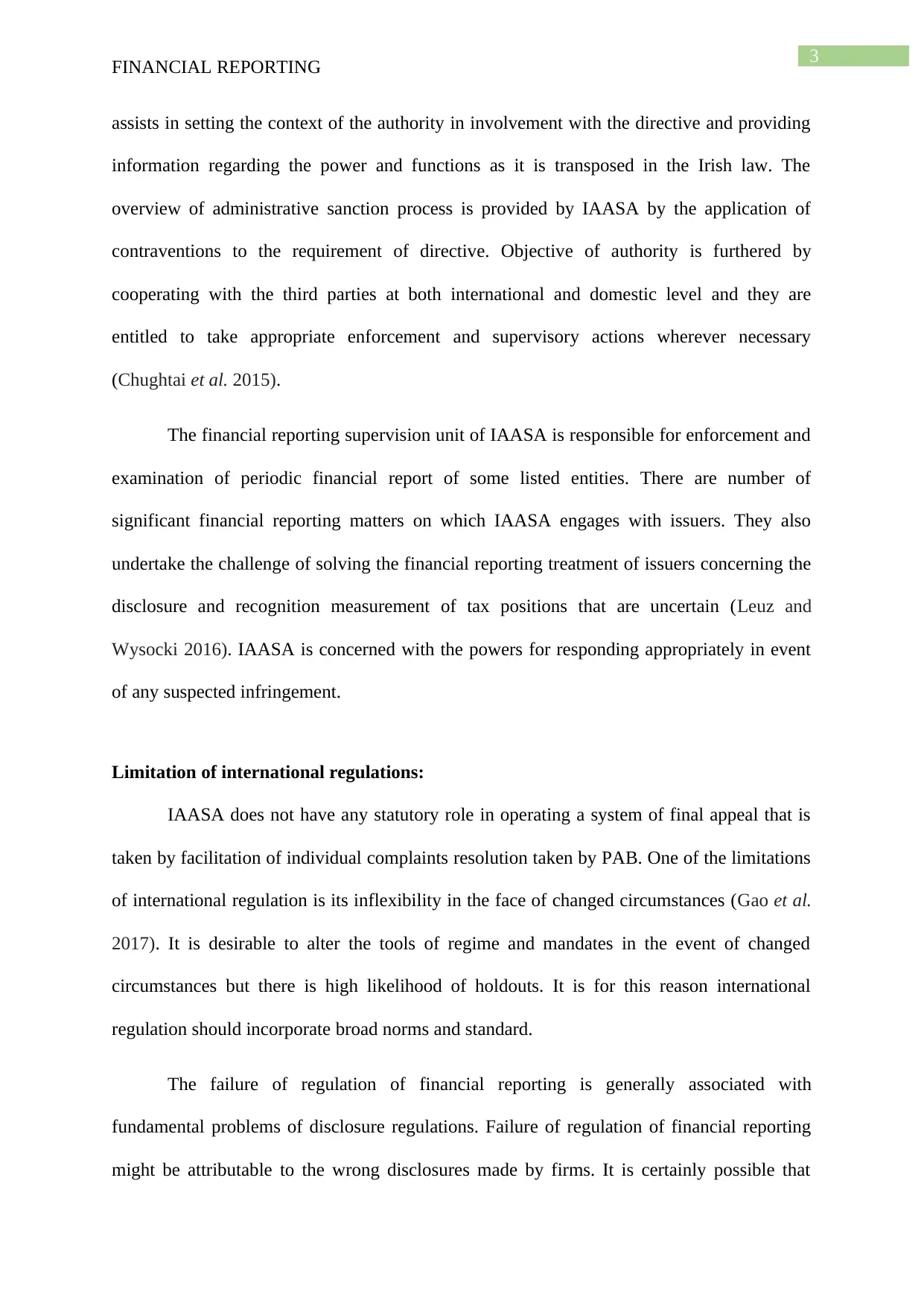
3
FINANCIAL REPORTING
assists in setting the context of the authority in involvement with the directive and providing
information regarding the power and functions as it is transposed in the Irish law. The
overview of administrative sanction process is provided by IAASA by the application of
contraventions to the requirement of directive. Objective of authority is furthered by
cooperating with the third parties at both international and domestic level and they are
entitled to take appropriate enforcement and supervisory actions wherever necessary
(Chughtai et al. 2015).
The financial reporting supervision unit of IAASA is responsible for enforcement and
examination of periodic financial report of some listed entities. There are number of
significant financial reporting matters on which IAASA engages with issuers. They also
undertake the challenge of solving the financial reporting treatment of issuers concerning the
disclosure and recognition measurement of tax positions that are uncertain (Leuz and
Wysocki 2016). IAASA is concerned with the powers for responding appropriately in event
of any suspected infringement.
Limitation of international regulations:
IAASA does not have any statutory role in operating a system of final appeal that is
taken by facilitation of individual complaints resolution taken by PAB. One of the limitations
of international regulation is its inflexibility in the face of changed circumstances (Gao et al.
2017). It is desirable to alter the tools of regime and mandates in the event of changed
circumstances but there is high likelihood of holdouts. It is for this reason international
regulation should incorporate broad norms and standard.
The failure of regulation of financial reporting is generally associated with
fundamental problems of disclosure regulations. Failure of regulation of financial reporting
might be attributable to the wrong disclosures made by firms. It is certainly possible that
FINANCIAL REPORTING
assists in setting the context of the authority in involvement with the directive and providing
information regarding the power and functions as it is transposed in the Irish law. The
overview of administrative sanction process is provided by IAASA by the application of
contraventions to the requirement of directive. Objective of authority is furthered by
cooperating with the third parties at both international and domestic level and they are
entitled to take appropriate enforcement and supervisory actions wherever necessary
(Chughtai et al. 2015).
The financial reporting supervision unit of IAASA is responsible for enforcement and
examination of periodic financial report of some listed entities. There are number of
significant financial reporting matters on which IAASA engages with issuers. They also
undertake the challenge of solving the financial reporting treatment of issuers concerning the
disclosure and recognition measurement of tax positions that are uncertain (Leuz and
Wysocki 2016). IAASA is concerned with the powers for responding appropriately in event
of any suspected infringement.
Limitation of international regulations:
IAASA does not have any statutory role in operating a system of final appeal that is
taken by facilitation of individual complaints resolution taken by PAB. One of the limitations
of international regulation is its inflexibility in the face of changed circumstances (Gao et al.
2017). It is desirable to alter the tools of regime and mandates in the event of changed
circumstances but there is high likelihood of holdouts. It is for this reason international
regulation should incorporate broad norms and standard.
The failure of regulation of financial reporting is generally associated with
fundamental problems of disclosure regulations. Failure of regulation of financial reporting
might be attributable to the wrong disclosures made by firms. It is certainly possible that
Paraphrase This Document
Need a fresh take? Get an instant paraphrase of this document with our AI Paraphraser
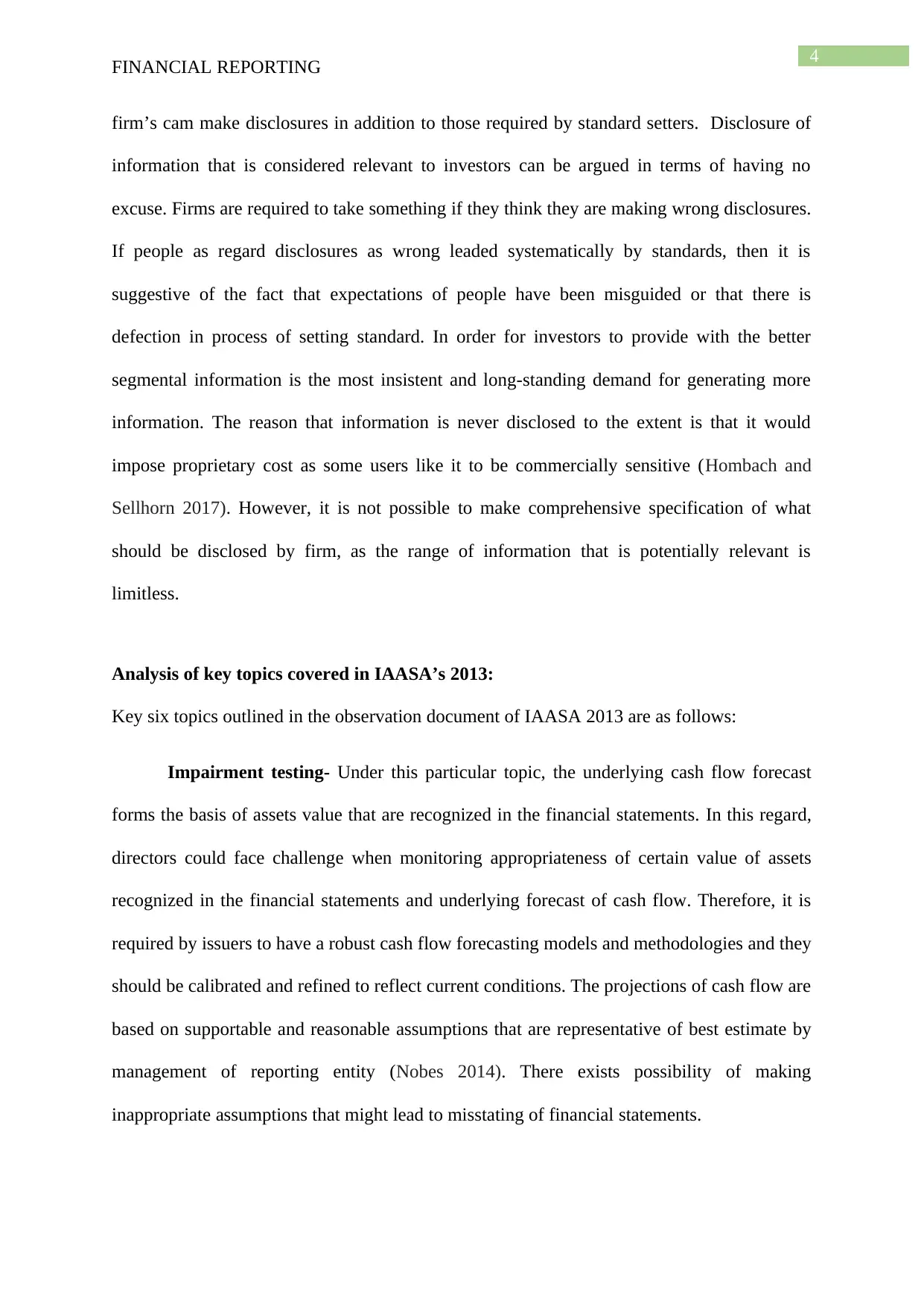
4
FINANCIAL REPORTING
firm’s cam make disclosures in addition to those required by standard setters. Disclosure of
information that is considered relevant to investors can be argued in terms of having no
excuse. Firms are required to take something if they think they are making wrong disclosures.
If people as regard disclosures as wrong leaded systematically by standards, then it is
suggestive of the fact that expectations of people have been misguided or that there is
defection in process of setting standard. In order for investors to provide with the better
segmental information is the most insistent and long-standing demand for generating more
information. The reason that information is never disclosed to the extent is that it would
impose proprietary cost as some users like it to be commercially sensitive (Hombach and
Sellhorn 2017). However, it is not possible to make comprehensive specification of what
should be disclosed by firm, as the range of information that is potentially relevant is
limitless.
Analysis of key topics covered in IAASA’s 2013:
Key six topics outlined in the observation document of IAASA 2013 are as follows:
Impairment testing- Under this particular topic, the underlying cash flow forecast
forms the basis of assets value that are recognized in the financial statements. In this regard,
directors could face challenge when monitoring appropriateness of certain value of assets
recognized in the financial statements and underlying forecast of cash flow. Therefore, it is
required by issuers to have a robust cash flow forecasting models and methodologies and they
should be calibrated and refined to reflect current conditions. The projections of cash flow are
based on supportable and reasonable assumptions that are representative of best estimate by
management of reporting entity (Nobes 2014). There exists possibility of making
inappropriate assumptions that might lead to misstating of financial statements.
FINANCIAL REPORTING
firm’s cam make disclosures in addition to those required by standard setters. Disclosure of
information that is considered relevant to investors can be argued in terms of having no
excuse. Firms are required to take something if they think they are making wrong disclosures.
If people as regard disclosures as wrong leaded systematically by standards, then it is
suggestive of the fact that expectations of people have been misguided or that there is
defection in process of setting standard. In order for investors to provide with the better
segmental information is the most insistent and long-standing demand for generating more
information. The reason that information is never disclosed to the extent is that it would
impose proprietary cost as some users like it to be commercially sensitive (Hombach and
Sellhorn 2017). However, it is not possible to make comprehensive specification of what
should be disclosed by firm, as the range of information that is potentially relevant is
limitless.
Analysis of key topics covered in IAASA’s 2013:
Key six topics outlined in the observation document of IAASA 2013 are as follows:
Impairment testing- Under this particular topic, the underlying cash flow forecast
forms the basis of assets value that are recognized in the financial statements. In this regard,
directors could face challenge when monitoring appropriateness of certain value of assets
recognized in the financial statements and underlying forecast of cash flow. Therefore, it is
required by issuers to have a robust cash flow forecasting models and methodologies and they
should be calibrated and refined to reflect current conditions. The projections of cash flow are
based on supportable and reasonable assumptions that are representative of best estimate by
management of reporting entity (Nobes 2014). There exists possibility of making
inappropriate assumptions that might lead to misstating of financial statements.
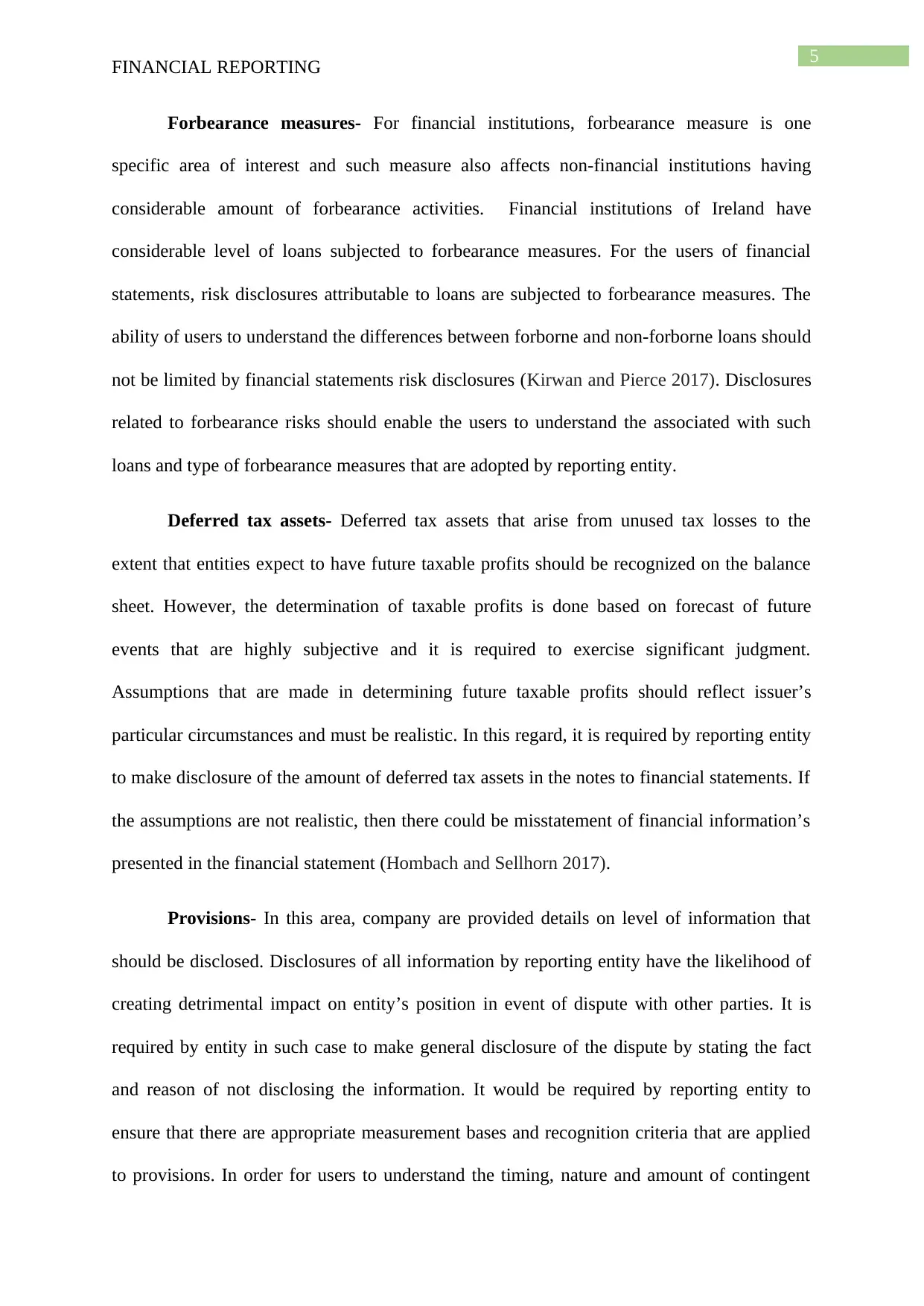
5
FINANCIAL REPORTING
Forbearance measures- For financial institutions, forbearance measure is one
specific area of interest and such measure also affects non-financial institutions having
considerable amount of forbearance activities. Financial institutions of Ireland have
considerable level of loans subjected to forbearance measures. For the users of financial
statements, risk disclosures attributable to loans are subjected to forbearance measures. The
ability of users to understand the differences between forborne and non-forborne loans should
not be limited by financial statements risk disclosures (Kirwan and Pierce 2017). Disclosures
related to forbearance risks should enable the users to understand the associated with such
loans and type of forbearance measures that are adopted by reporting entity.
Deferred tax assets- Deferred tax assets that arise from unused tax losses to the
extent that entities expect to have future taxable profits should be recognized on the balance
sheet. However, the determination of taxable profits is done based on forecast of future
events that are highly subjective and it is required to exercise significant judgment.
Assumptions that are made in determining future taxable profits should reflect issuer’s
particular circumstances and must be realistic. In this regard, it is required by reporting entity
to make disclosure of the amount of deferred tax assets in the notes to financial statements. If
the assumptions are not realistic, then there could be misstatement of financial information’s
presented in the financial statement (Hombach and Sellhorn 2017).
Provisions- In this area, company are provided details on level of information that
should be disclosed. Disclosures of all information by reporting entity have the likelihood of
creating detrimental impact on entity’s position in event of dispute with other parties. It is
required by entity in such case to make general disclosure of the dispute by stating the fact
and reason of not disclosing the information. It would be required by reporting entity to
ensure that there are appropriate measurement bases and recognition criteria that are applied
to provisions. In order for users to understand the timing, nature and amount of contingent
FINANCIAL REPORTING
Forbearance measures- For financial institutions, forbearance measure is one
specific area of interest and such measure also affects non-financial institutions having
considerable amount of forbearance activities. Financial institutions of Ireland have
considerable level of loans subjected to forbearance measures. For the users of financial
statements, risk disclosures attributable to loans are subjected to forbearance measures. The
ability of users to understand the differences between forborne and non-forborne loans should
not be limited by financial statements risk disclosures (Kirwan and Pierce 2017). Disclosures
related to forbearance risks should enable the users to understand the associated with such
loans and type of forbearance measures that are adopted by reporting entity.
Deferred tax assets- Deferred tax assets that arise from unused tax losses to the
extent that entities expect to have future taxable profits should be recognized on the balance
sheet. However, the determination of taxable profits is done based on forecast of future
events that are highly subjective and it is required to exercise significant judgment.
Assumptions that are made in determining future taxable profits should reflect issuer’s
particular circumstances and must be realistic. In this regard, it is required by reporting entity
to make disclosure of the amount of deferred tax assets in the notes to financial statements. If
the assumptions are not realistic, then there could be misstatement of financial information’s
presented in the financial statement (Hombach and Sellhorn 2017).
Provisions- In this area, company are provided details on level of information that
should be disclosed. Disclosures of all information by reporting entity have the likelihood of
creating detrimental impact on entity’s position in event of dispute with other parties. It is
required by entity in such case to make general disclosure of the dispute by stating the fact
and reason of not disclosing the information. It would be required by reporting entity to
ensure that there are appropriate measurement bases and recognition criteria that are applied
to provisions. In order for users to understand the timing, nature and amount of contingent
⊘ This is a preview!⊘
Do you want full access?
Subscribe today to unlock all pages.

Trusted by 1+ million students worldwide
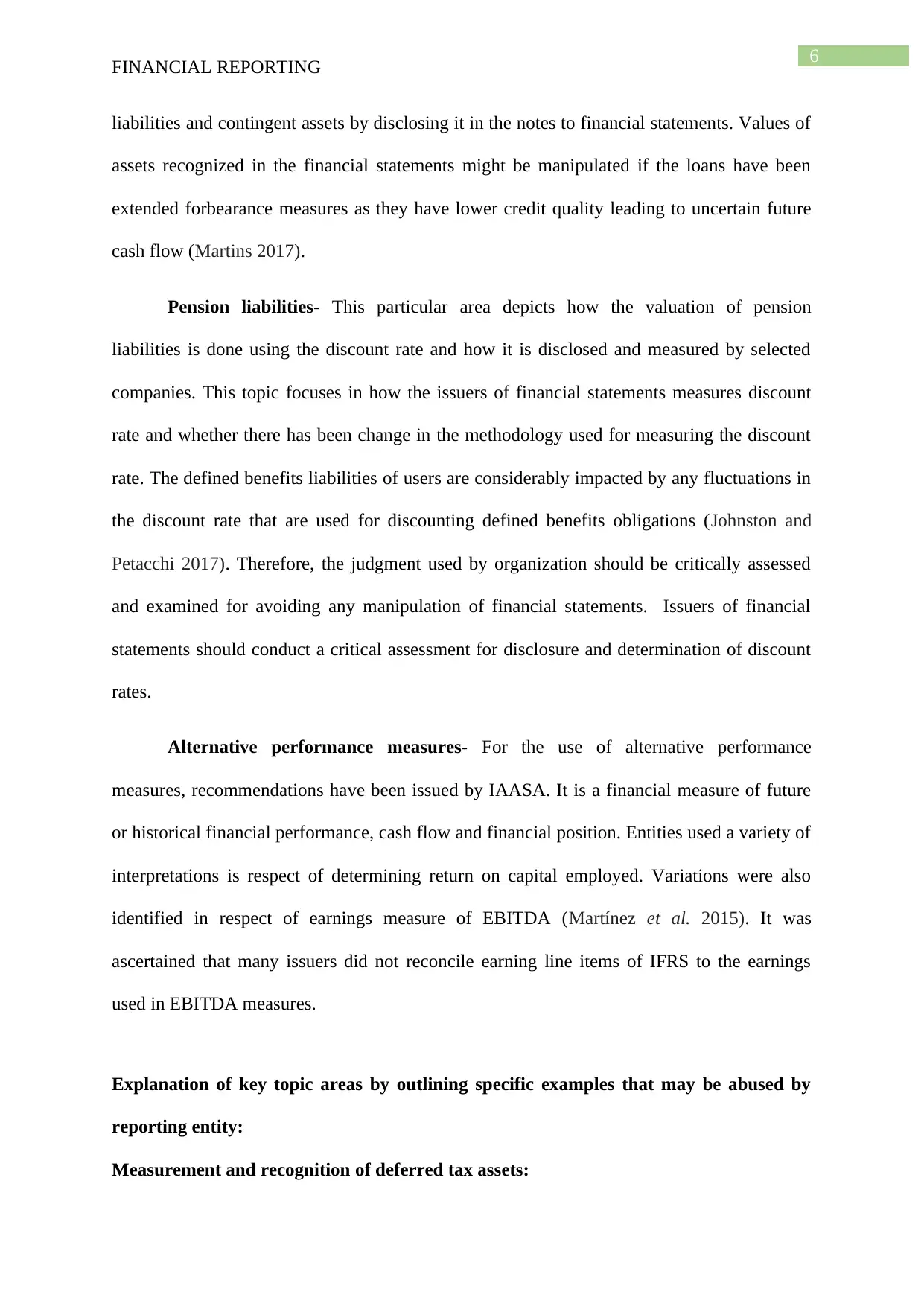
6
FINANCIAL REPORTING
liabilities and contingent assets by disclosing it in the notes to financial statements. Values of
assets recognized in the financial statements might be manipulated if the loans have been
extended forbearance measures as they have lower credit quality leading to uncertain future
cash flow (Martins 2017).
Pension liabilities- This particular area depicts how the valuation of pension
liabilities is done using the discount rate and how it is disclosed and measured by selected
companies. This topic focuses in how the issuers of financial statements measures discount
rate and whether there has been change in the methodology used for measuring the discount
rate. The defined benefits liabilities of users are considerably impacted by any fluctuations in
the discount rate that are used for discounting defined benefits obligations (Johnston and
Petacchi 2017). Therefore, the judgment used by organization should be critically assessed
and examined for avoiding any manipulation of financial statements. Issuers of financial
statements should conduct a critical assessment for disclosure and determination of discount
rates.
Alternative performance measures- For the use of alternative performance
measures, recommendations have been issued by IAASA. It is a financial measure of future
or historical financial performance, cash flow and financial position. Entities used a variety of
interpretations is respect of determining return on capital employed. Variations were also
identified in respect of earnings measure of EBITDA (Martínez et al. 2015). It was
ascertained that many issuers did not reconcile earning line items of IFRS to the earnings
used in EBITDA measures.
Explanation of key topic areas by outlining specific examples that may be abused by
reporting entity:
Measurement and recognition of deferred tax assets:
FINANCIAL REPORTING
liabilities and contingent assets by disclosing it in the notes to financial statements. Values of
assets recognized in the financial statements might be manipulated if the loans have been
extended forbearance measures as they have lower credit quality leading to uncertain future
cash flow (Martins 2017).
Pension liabilities- This particular area depicts how the valuation of pension
liabilities is done using the discount rate and how it is disclosed and measured by selected
companies. This topic focuses in how the issuers of financial statements measures discount
rate and whether there has been change in the methodology used for measuring the discount
rate. The defined benefits liabilities of users are considerably impacted by any fluctuations in
the discount rate that are used for discounting defined benefits obligations (Johnston and
Petacchi 2017). Therefore, the judgment used by organization should be critically assessed
and examined for avoiding any manipulation of financial statements. Issuers of financial
statements should conduct a critical assessment for disclosure and determination of discount
rates.
Alternative performance measures- For the use of alternative performance
measures, recommendations have been issued by IAASA. It is a financial measure of future
or historical financial performance, cash flow and financial position. Entities used a variety of
interpretations is respect of determining return on capital employed. Variations were also
identified in respect of earnings measure of EBITDA (Martínez et al. 2015). It was
ascertained that many issuers did not reconcile earning line items of IFRS to the earnings
used in EBITDA measures.
Explanation of key topic areas by outlining specific examples that may be abused by
reporting entity:
Measurement and recognition of deferred tax assets:
Paraphrase This Document
Need a fresh take? Get an instant paraphrase of this document with our AI Paraphraser
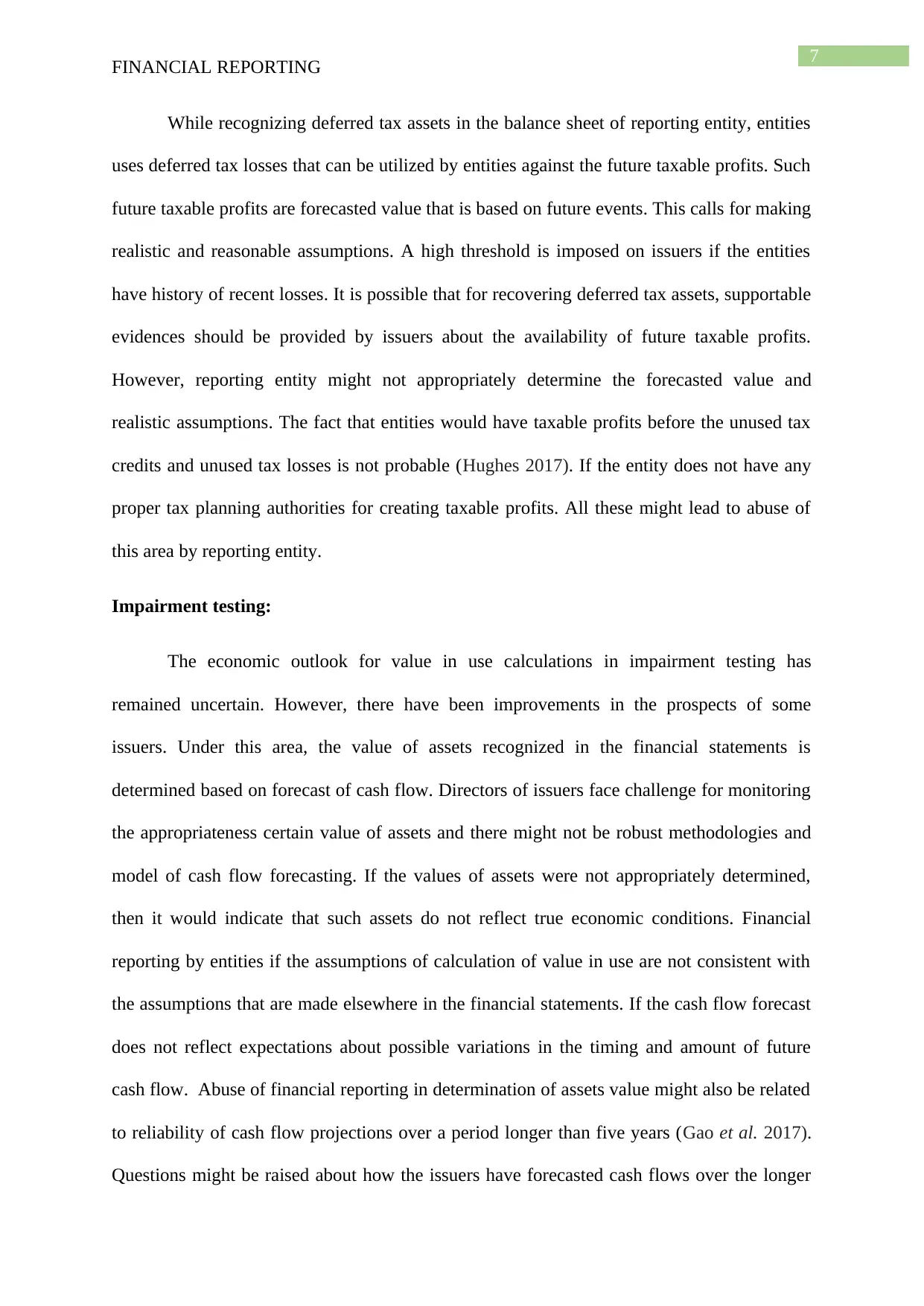
7
FINANCIAL REPORTING
While recognizing deferred tax assets in the balance sheet of reporting entity, entities
uses deferred tax losses that can be utilized by entities against the future taxable profits. Such
future taxable profits are forecasted value that is based on future events. This calls for making
realistic and reasonable assumptions. A high threshold is imposed on issuers if the entities
have history of recent losses. It is possible that for recovering deferred tax assets, supportable
evidences should be provided by issuers about the availability of future taxable profits.
However, reporting entity might not appropriately determine the forecasted value and
realistic assumptions. The fact that entities would have taxable profits before the unused tax
credits and unused tax losses is not probable (Hughes 2017). If the entity does not have any
proper tax planning authorities for creating taxable profits. All these might lead to abuse of
this area by reporting entity.
Impairment testing:
The economic outlook for value in use calculations in impairment testing has
remained uncertain. However, there have been improvements in the prospects of some
issuers. Under this area, the value of assets recognized in the financial statements is
determined based on forecast of cash flow. Directors of issuers face challenge for monitoring
the appropriateness certain value of assets and there might not be robust methodologies and
model of cash flow forecasting. If the values of assets were not appropriately determined,
then it would indicate that such assets do not reflect true economic conditions. Financial
reporting by entities if the assumptions of calculation of value in use are not consistent with
the assumptions that are made elsewhere in the financial statements. If the cash flow forecast
does not reflect expectations about possible variations in the timing and amount of future
cash flow. Abuse of financial reporting in determination of assets value might also be related
to reliability of cash flow projections over a period longer than five years (Gao et al. 2017).
Questions might be raised about how the issuers have forecasted cash flows over the longer
FINANCIAL REPORTING
While recognizing deferred tax assets in the balance sheet of reporting entity, entities
uses deferred tax losses that can be utilized by entities against the future taxable profits. Such
future taxable profits are forecasted value that is based on future events. This calls for making
realistic and reasonable assumptions. A high threshold is imposed on issuers if the entities
have history of recent losses. It is possible that for recovering deferred tax assets, supportable
evidences should be provided by issuers about the availability of future taxable profits.
However, reporting entity might not appropriately determine the forecasted value and
realistic assumptions. The fact that entities would have taxable profits before the unused tax
credits and unused tax losses is not probable (Hughes 2017). If the entity does not have any
proper tax planning authorities for creating taxable profits. All these might lead to abuse of
this area by reporting entity.
Impairment testing:
The economic outlook for value in use calculations in impairment testing has
remained uncertain. However, there have been improvements in the prospects of some
issuers. Under this area, the value of assets recognized in the financial statements is
determined based on forecast of cash flow. Directors of issuers face challenge for monitoring
the appropriateness certain value of assets and there might not be robust methodologies and
model of cash flow forecasting. If the values of assets were not appropriately determined,
then it would indicate that such assets do not reflect true economic conditions. Financial
reporting by entities if the assumptions of calculation of value in use are not consistent with
the assumptions that are made elsewhere in the financial statements. If the cash flow forecast
does not reflect expectations about possible variations in the timing and amount of future
cash flow. Abuse of financial reporting in determination of assets value might also be related
to reliability of cash flow projections over a period longer than five years (Gao et al. 2017).
Questions might be raised about how the issuers have forecasted cash flows over the longer
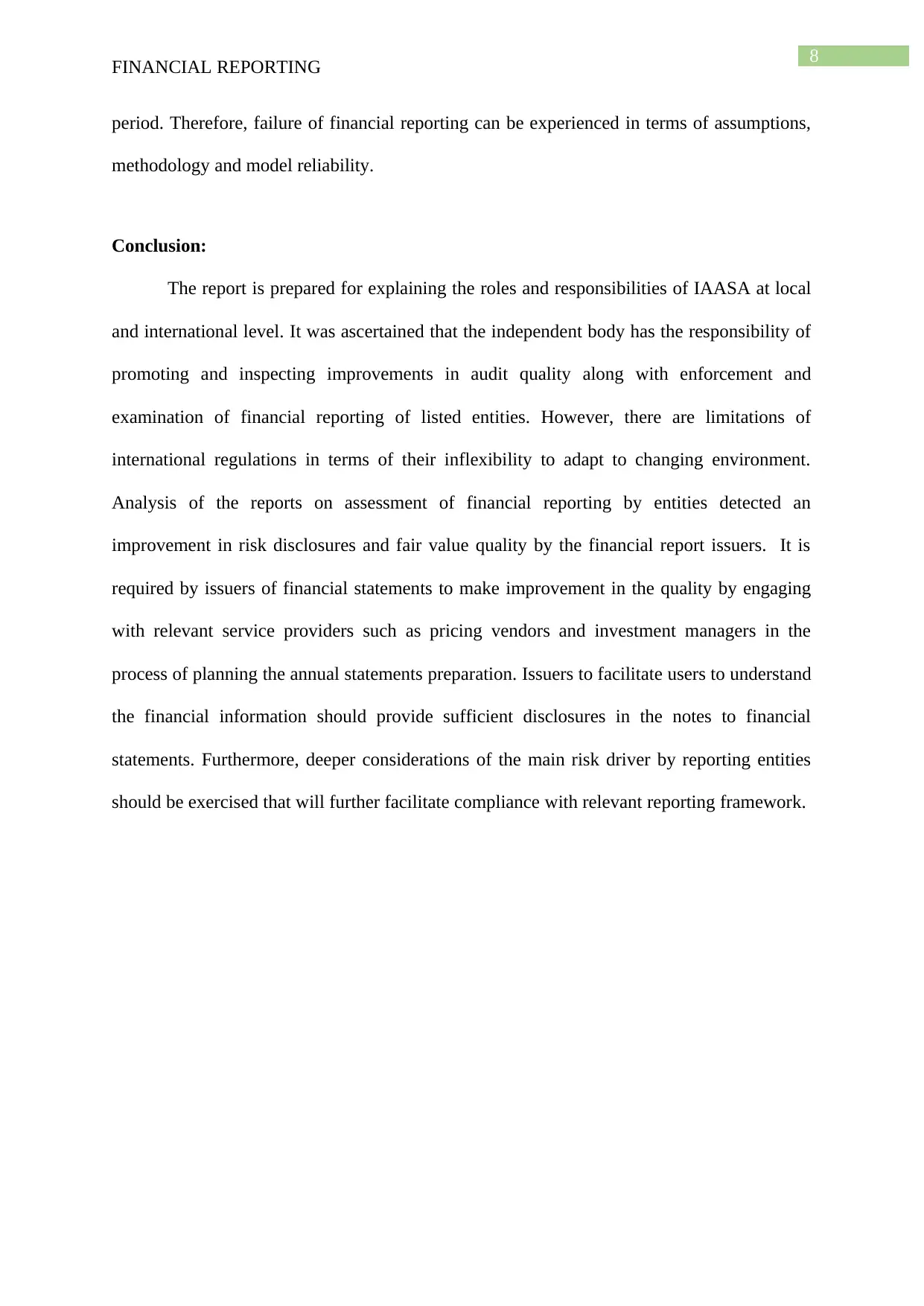
8
FINANCIAL REPORTING
period. Therefore, failure of financial reporting can be experienced in terms of assumptions,
methodology and model reliability.
Conclusion:
The report is prepared for explaining the roles and responsibilities of IAASA at local
and international level. It was ascertained that the independent body has the responsibility of
promoting and inspecting improvements in audit quality along with enforcement and
examination of financial reporting of listed entities. However, there are limitations of
international regulations in terms of their inflexibility to adapt to changing environment.
Analysis of the reports on assessment of financial reporting by entities detected an
improvement in risk disclosures and fair value quality by the financial report issuers. It is
required by issuers of financial statements to make improvement in the quality by engaging
with relevant service providers such as pricing vendors and investment managers in the
process of planning the annual statements preparation. Issuers to facilitate users to understand
the financial information should provide sufficient disclosures in the notes to financial
statements. Furthermore, deeper considerations of the main risk driver by reporting entities
should be exercised that will further facilitate compliance with relevant reporting framework.
FINANCIAL REPORTING
period. Therefore, failure of financial reporting can be experienced in terms of assumptions,
methodology and model reliability.
Conclusion:
The report is prepared for explaining the roles and responsibilities of IAASA at local
and international level. It was ascertained that the independent body has the responsibility of
promoting and inspecting improvements in audit quality along with enforcement and
examination of financial reporting of listed entities. However, there are limitations of
international regulations in terms of their inflexibility to adapt to changing environment.
Analysis of the reports on assessment of financial reporting by entities detected an
improvement in risk disclosures and fair value quality by the financial report issuers. It is
required by issuers of financial statements to make improvement in the quality by engaging
with relevant service providers such as pricing vendors and investment managers in the
process of planning the annual statements preparation. Issuers to facilitate users to understand
the financial information should provide sufficient disclosures in the notes to financial
statements. Furthermore, deeper considerations of the main risk driver by reporting entities
should be exercised that will further facilitate compliance with relevant reporting framework.
⊘ This is a preview!⊘
Do you want full access?
Subscribe today to unlock all pages.

Trusted by 1+ million students worldwide
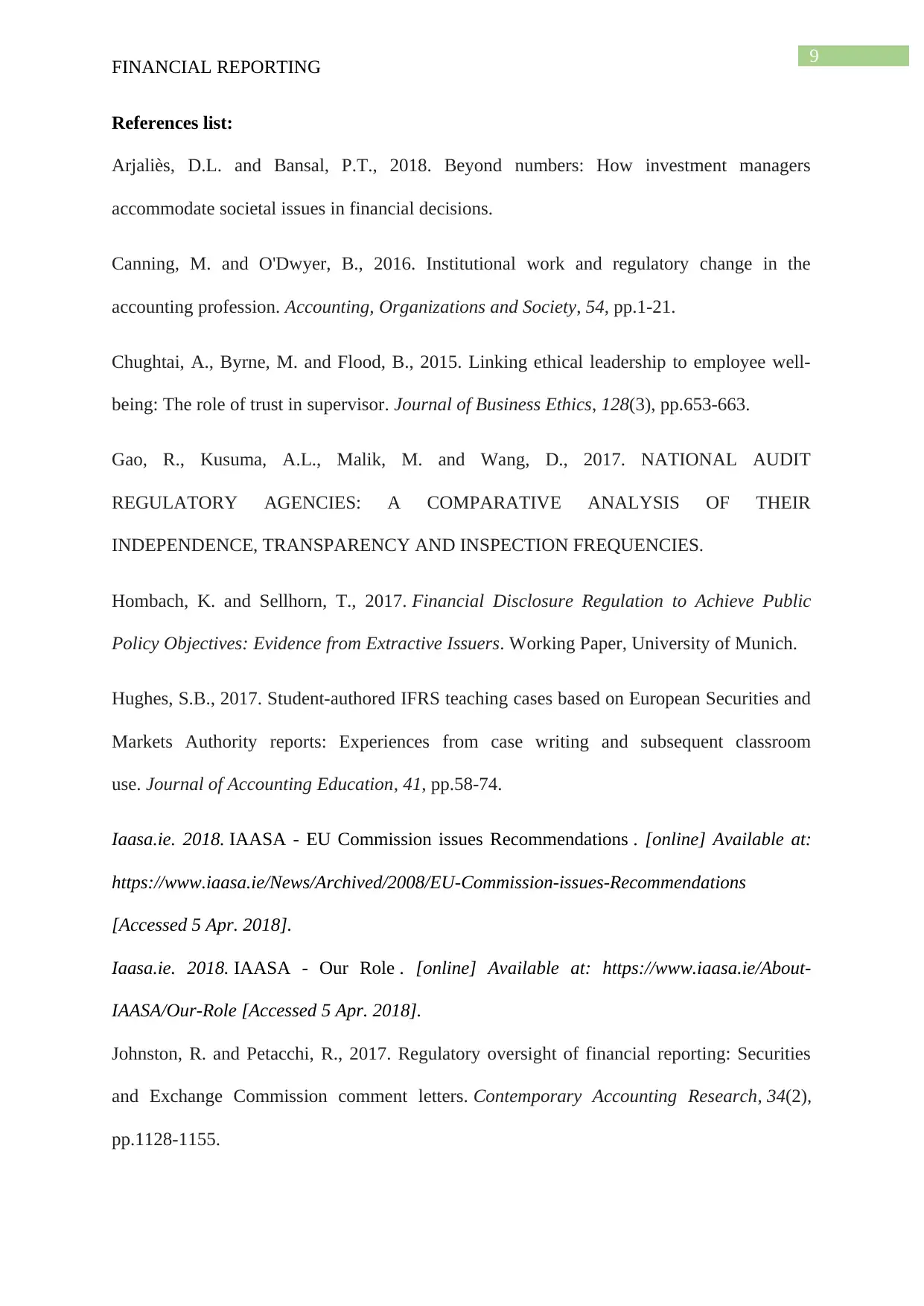
9
FINANCIAL REPORTING
References list:
Arjaliès, D.L. and Bansal, P.T., 2018. Beyond numbers: How investment managers
accommodate societal issues in financial decisions.
Canning, M. and O'Dwyer, B., 2016. Institutional work and regulatory change in the
accounting profession. Accounting, Organizations and Society, 54, pp.1-21.
Chughtai, A., Byrne, M. and Flood, B., 2015. Linking ethical leadership to employee well-
being: The role of trust in supervisor. Journal of Business Ethics, 128(3), pp.653-663.
Gao, R., Kusuma, A.L., Malik, M. and Wang, D., 2017. NATIONAL AUDIT
REGULATORY AGENCIES: A COMPARATIVE ANALYSIS OF THEIR
INDEPENDENCE, TRANSPARENCY AND INSPECTION FREQUENCIES.
Hombach, K. and Sellhorn, T., 2017. Financial Disclosure Regulation to Achieve Public
Policy Objectives: Evidence from Extractive Issuers. Working Paper, University of Munich.
Hughes, S.B., 2017. Student-authored IFRS teaching cases based on European Securities and
Markets Authority reports: Experiences from case writing and subsequent classroom
use. Journal of Accounting Education, 41, pp.58-74.
Iaasa.ie. 2018. IAASA - EU Commission issues Recommendations . [online] Available at:
https://www.iaasa.ie/News/Archived/2008/EU-Commission-issues-Recommendations
[Accessed 5 Apr. 2018].
Iaasa.ie. 2018. IAASA - Our Role . [online] Available at: https://www.iaasa.ie/About-
IAASA/Our-Role [Accessed 5 Apr. 2018].
Johnston, R. and Petacchi, R., 2017. Regulatory oversight of financial reporting: Securities
and Exchange Commission comment letters. Contemporary Accounting Research, 34(2),
pp.1128-1155.
FINANCIAL REPORTING
References list:
Arjaliès, D.L. and Bansal, P.T., 2018. Beyond numbers: How investment managers
accommodate societal issues in financial decisions.
Canning, M. and O'Dwyer, B., 2016. Institutional work and regulatory change in the
accounting profession. Accounting, Organizations and Society, 54, pp.1-21.
Chughtai, A., Byrne, M. and Flood, B., 2015. Linking ethical leadership to employee well-
being: The role of trust in supervisor. Journal of Business Ethics, 128(3), pp.653-663.
Gao, R., Kusuma, A.L., Malik, M. and Wang, D., 2017. NATIONAL AUDIT
REGULATORY AGENCIES: A COMPARATIVE ANALYSIS OF THEIR
INDEPENDENCE, TRANSPARENCY AND INSPECTION FREQUENCIES.
Hombach, K. and Sellhorn, T., 2017. Financial Disclosure Regulation to Achieve Public
Policy Objectives: Evidence from Extractive Issuers. Working Paper, University of Munich.
Hughes, S.B., 2017. Student-authored IFRS teaching cases based on European Securities and
Markets Authority reports: Experiences from case writing and subsequent classroom
use. Journal of Accounting Education, 41, pp.58-74.
Iaasa.ie. 2018. IAASA - EU Commission issues Recommendations . [online] Available at:
https://www.iaasa.ie/News/Archived/2008/EU-Commission-issues-Recommendations
[Accessed 5 Apr. 2018].
Iaasa.ie. 2018. IAASA - Our Role . [online] Available at: https://www.iaasa.ie/About-
IAASA/Our-Role [Accessed 5 Apr. 2018].
Johnston, R. and Petacchi, R., 2017. Regulatory oversight of financial reporting: Securities
and Exchange Commission comment letters. Contemporary Accounting Research, 34(2),
pp.1128-1155.
Paraphrase This Document
Need a fresh take? Get an instant paraphrase of this document with our AI Paraphraser
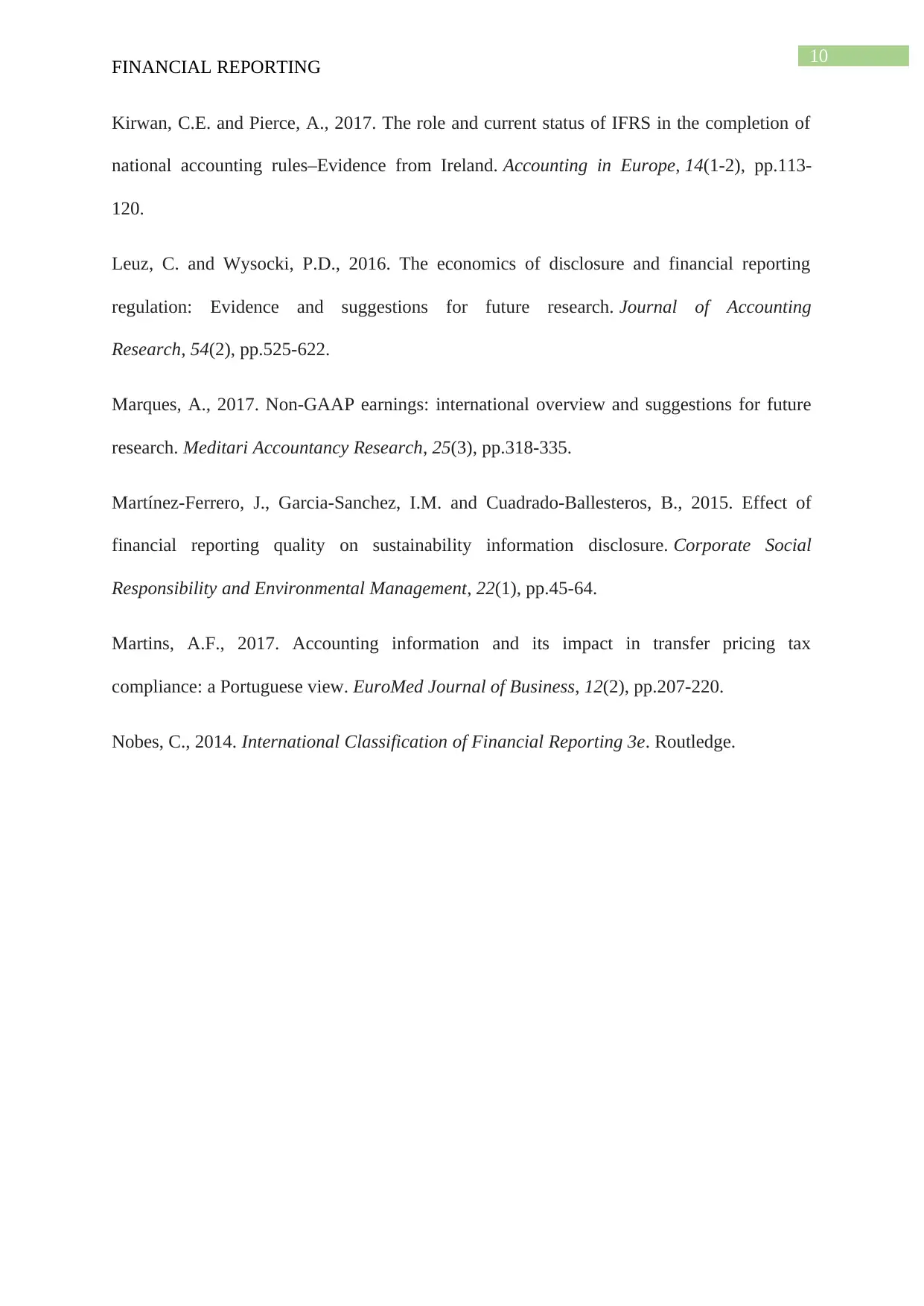
10
FINANCIAL REPORTING
Kirwan, C.E. and Pierce, A., 2017. The role and current status of IFRS in the completion of
national accounting rules–Evidence from Ireland. Accounting in Europe, 14(1-2), pp.113-
120.
Leuz, C. and Wysocki, P.D., 2016. The economics of disclosure and financial reporting
regulation: Evidence and suggestions for future research. Journal of Accounting
Research, 54(2), pp.525-622.
Marques, A., 2017. Non-GAAP earnings: international overview and suggestions for future
research. Meditari Accountancy Research, 25(3), pp.318-335.
Martínez‐Ferrero, J., Garcia‐Sanchez, I.M. and Cuadrado‐Ballesteros, B., 2015. Effect of
financial reporting quality on sustainability information disclosure. Corporate Social
Responsibility and Environmental Management, 22(1), pp.45-64.
Martins, A.F., 2017. Accounting information and its impact in transfer pricing tax
compliance: a Portuguese view. EuroMed Journal of Business, 12(2), pp.207-220.
Nobes, C., 2014. International Classification of Financial Reporting 3e. Routledge.
FINANCIAL REPORTING
Kirwan, C.E. and Pierce, A., 2017. The role and current status of IFRS in the completion of
national accounting rules–Evidence from Ireland. Accounting in Europe, 14(1-2), pp.113-
120.
Leuz, C. and Wysocki, P.D., 2016. The economics of disclosure and financial reporting
regulation: Evidence and suggestions for future research. Journal of Accounting
Research, 54(2), pp.525-622.
Marques, A., 2017. Non-GAAP earnings: international overview and suggestions for future
research. Meditari Accountancy Research, 25(3), pp.318-335.
Martínez‐Ferrero, J., Garcia‐Sanchez, I.M. and Cuadrado‐Ballesteros, B., 2015. Effect of
financial reporting quality on sustainability information disclosure. Corporate Social
Responsibility and Environmental Management, 22(1), pp.45-64.
Martins, A.F., 2017. Accounting information and its impact in transfer pricing tax
compliance: a Portuguese view. EuroMed Journal of Business, 12(2), pp.207-220.
Nobes, C., 2014. International Classification of Financial Reporting 3e. Routledge.
1 out of 11
Related Documents
Your All-in-One AI-Powered Toolkit for Academic Success.
+13062052269
info@desklib.com
Available 24*7 on WhatsApp / Email
![[object Object]](/_next/static/media/star-bottom.7253800d.svg)
Unlock your academic potential
Copyright © 2020–2025 A2Z Services. All Rights Reserved. Developed and managed by ZUCOL.




